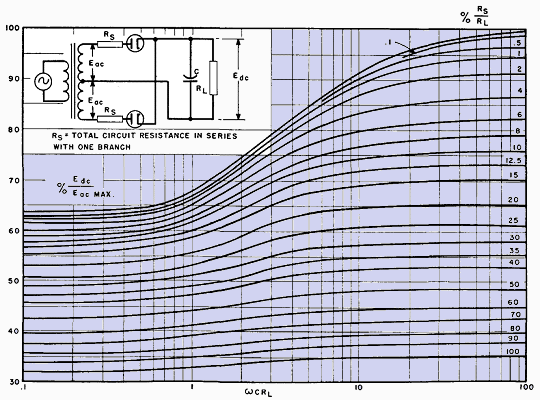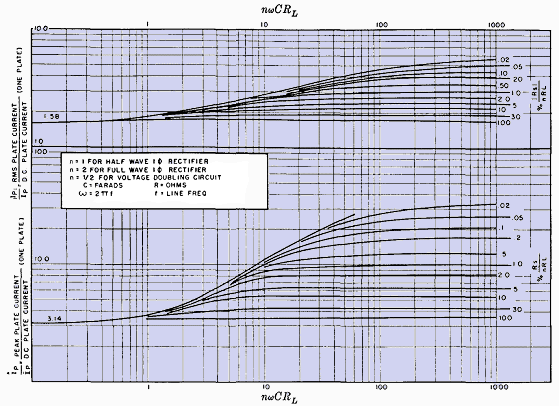| Electronic Transformers and Circuits is a free introductory textbook on transformers and related circuits. See the editorial for more information.... |

|

Home  Rectifier Transformers and Reactors Rectifier Transformers and Reactors  Rectifiers with Capacitor-Input Filters Rectifiers with Capacitor-Input Filters |
||||||||||||||||
| See also: Single-Phase Rectifiers, Rectifiers with Reactor-Input Filters, Polyphase Rectifiers, Capacitor-Input Filters | ||||||||||||||||






|
||||||||||||||||
Rectifiers with Capacitor-Input Filters
When the filter has no reactor intervening between rectifier and first capacitor, rectifier current is not continuous throughout each cycle and the rectified wave form changes. During the voltage peaks of each cycle, the capacitor charges and draws current from the rectifier. During the rest of the time, no current is drawn from the rectifier, and the capacitor discharges into the load.
Analysis of this charge-discharge action involves complicated Fourier series which require a long time to calculate.(1) Satisfactory voltage and current values have been obtained from experimental measurements by Schade (2) and are shown in Figs. 50, 51, and 52 for single-phase half-wave and full-wave rectifiers.
In these figures Rs is the rectifier series resistance, including the transformer resistance.
Results accurate to within 5 per cent are obtained if the rectifier resistance corresponding to peak current In Fig. 52 the peak current indicates whether the peak current of a given tube is exceeded, and the rms current determines the transformer secondary heating. The v-a ratings are greater, but ratios of primary to secondary v-a ratings given in Table VII hold for capacitor-input transformers also.
|
||||||||||||||||
Home  Rectifier Transformers and Reactors Rectifier Transformers and Reactors  Rectifiers with Capacitor-Input Filters Rectifiers with Capacitor-Input Filters |
||||||||||||||||
Last Update: 2011-02-17






 is used in finding Rs. The process is cut-and-try, because
is used in finding Rs. The process is cut-and-try, because depends on Rs, and vice versa, but two trials usually suffice. Resistance is in ohms, capacitance is in farads, and ω is 2π times the supply frequency. Three-phase rectifiers are rarely capacitor-input because of their larger power.
depends on Rs, and vice versa, but two trials usually suffice. Resistance is in ohms, capacitance is in farads, and ω is 2π times the supply frequency. Three-phase rectifiers are rarely capacitor-input because of their larger power.